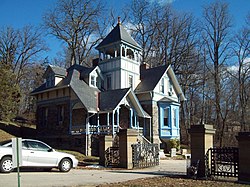
Woodlawn is an unincorporated community and census-designated place in Baltimore County, Maryland. Per the 2020 census, the population was 39,986. It is home to the headquarters of the Social Security Administration (SSA) and the Centers for Medicare and Medicaid Services (CMS). It is bordered by Catonsville on the south, by the Patapsco River and Howard County on the west, by Randallstown and Lochearn to the north, and by the City of Baltimore to the east. Parts of Woodlawn are sometimes informally referred to as Security, Maryland, due to the importance of the SSA's headquarters as well as nearby Security Boulevard and Security Square Mall.
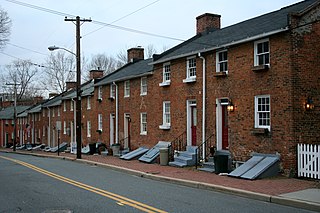
Oella is a mill town on the Patapsco River in western Baltimore County, Maryland, United States, located between Catonsville and Ellicott City. It is a 19th-century village of millworkers' homes.

The Craighill Channel Lower Range Rear Light is one of a pair of range lights that marks the first section of the shipping channel into Baltimore harbor. It is the tallest lighthouse in Maryland.

The Craighill Channel Upper Range Rear Light is one of a pair of range lights that marks the second section of the shipping channel into Baltimore harbor.
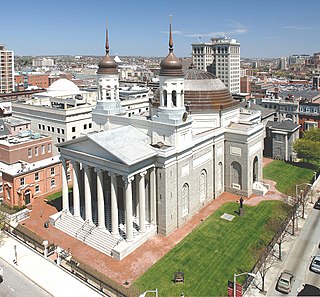
The Cathedral Hill Historic District is an area in Baltimore, Maryland. It lies in the northern part of Downtown just south of Mount Vernon. Roughly bounded by Saratoga Street, Park Avenue, Hamilton Street, and St. Paul Street, these 10 or so blocks contain some of the most significant buildings in Baltimore. The area takes its name from the Basilica of the Assumption which sits in the heart of the district. Despite the number of large religious structures in the area, the district's buildings are primarily commercial in character, with a broad collection of significant commercial structures ranging in date from 1790 to 1940.

St. Thomas' Church is an Episcopal church in a rural setting, located at Croom, Prince George's County, Maryland. It is one of four congregations that have constituted the parish of St. Thomas in the Episcopal Diocese of Washington, the others including the Church of the Atonement in Cheltenham, the Chapel of the Incarnation in Brandywine, and St. Simon's Mission also in Croom.
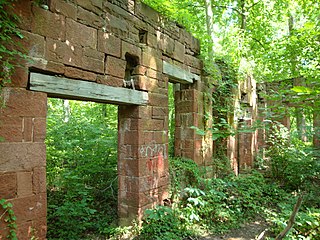
Seneca Quarry is a historic site located at Seneca, Montgomery County, Maryland. It is located along the Chesapeake and Ohio Canal on the north bank of the Potomac River, just west of Seneca Creek. The quarry was the source of stone for two Potomac River canals: the Patowmack Canal on the Virginia side of Great Falls; and the C&O Canal, having supplied red sandstone for the latter for locks 9, 11, 15 - 27, and 30, the accompanying lock houses, and Aqueduct No. 1, better known as Seneca Aqueduct, constructed from 1828 to 1833.
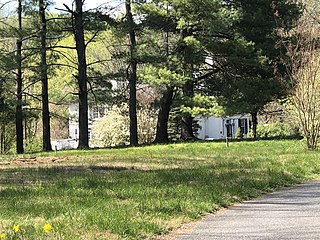
The Commodore Joshua Barney House is a historic home located at Savage, Howard County, Maryland, United States. It was originally situated on a 700-acre tract in modern Savage Maryland named Harry's Lot, at a time when the closest town was Elk Ridge. Both "Haary's Lot" and "Huntington Quarter" were inherited by Charles Greenberry Ridgely, sixth son of Colonel Henry Ridgley and Elizabeth Warfield Ridgley. After the death of Charles Greenberry Ridgely, Thomas Coale purchased portions of the land containing the structure. His daughter would become the famous Commodore Joshua Barney's second wife, bringing the figure from business in Baltimore. In 1809, Nathaniel F. Williams (1782-1864) married Caroline Barney, daughter of Joshua Barney, who in turn expanded an existing mill site on the property to create the Savage Mill.
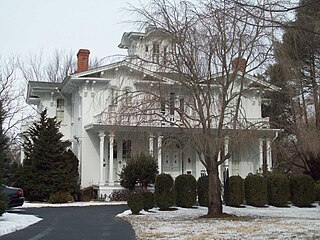
Temora, is a historic home located at Ellicott City, Howard County, Maryland. It is a T-shaped, two-story and cupola, Tuscan-style Victorian house of stuccoed tongue-and-groove boards. The house was built in 1857 after a design prepared by Norris G. Starkweather, a little-known but accomplished architect from Oxford, England, who also designed the First Presbyterian Church and Manse at West Madison Street and Park Avenue in the Mount Vernon-Belvedere neighborhood in Baltimore, Maryland, with his later more famous assistant - Edmund G. Lind. The house was built for Dr. Arthur Pue Jr. on land given from his grandmother Mary Dorsey Pue of Belmont Estate. The name of the estate Temora comes from the poems of Ossian
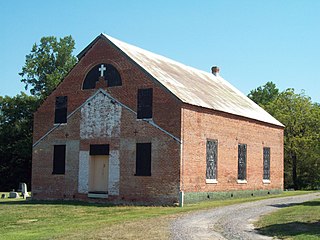
St. Mary's Catholic Church, Newport is a historic parish located in Newport, Charles County, Maryland, established in 1674. Several churches have been built on the property over its history. At present there are two churches remaining, one built in 1840, deconsecrated in 1906 and no longer used for religious services, and the current church building, built in 1954. The historic 1840 church is a rectangular brick structure, four bays in length and three bays wide. It is of simple architectural styling typical of the Greek Revival period in this locality. Located on the property is the parish cemetery, which includes the burial plot of the Brent-Merrick family, including congressman William Duhurst Merrick (1793–1857). It has several impressively scaled and ornamented monuments enclosed within a decorative mid-19th century wrought iron fence. Other memorial stones bear the signature of "A. Geddess," who founded the long-active Geddess monument firm of Baltimore in 1822.

Weiskittel-Roehle Burial Vault is a historic burial vault located in Section P, Loudon Park Cemetery, Baltimore, Maryland. It is a rectangular structure made of cast iron built into the side of a hill, constructed to look like ashlar masonry and painted gray. It was made as the tomb of Anton W. Weiskittel who died in 1884, a Baltimore iron founder.

Brooklandville House, or the Valley Inn, is a historic restaurant and tavern building, and a former inn, located in Brooklandville, Baltimore County, Maryland. It is a 2+1⁄2-story stone structure facing the former railroad and dating from about 1832. It is associated with the Baltimore and Susquehanna Railroad, which crossed the property just to the south.

The Cloisters, also known as Cloisters Castle, is a historic home in Lutherville, Baltimore County, Maryland, United States. The building was completed in 1932, after three years of construction. The house is 4 story house, irregular in elevation and plan with much architectural ornament. It is built of large, random-sized blocks of a native gray and gold colored rock known as Butler stone, with details principally of sandstone, wood from the site, plaster, and wrought iron. The main façade is dominated by two asymmetrically placed, projecting sections topped by massive half-timbered gables which were originally part of a Medieval house in Domrémy, France. It also has a massive stone octagonal stair tower, which contains a stone and wrought-iron spiral staircase and is crowned by a crenellated parapet and a small, round, stone-roofed structure from which one can exit onto the roof of the main tower. The house's roof is constructed of overlapping flagstones secured by iron pins, the only roof of this kind in America.

Clifton Park Valve House, also known as the Lake Clifton Gate House or Lake Clifton Valve House, is a historic building located in a northeast area known as Clifton Park of Baltimore, Maryland. It is a massive octagonal stone gatehouse featuring large Romanesque archways that alternate with Gothic style windows that once contained stained glass. It was constructed in 1887 by the Baltimore City Water Department. It also features a turret, atop an intricate tile roof supported by a complicated system of iron trusses.
Corbett Historic District is a national historic district at Monkton, Baltimore County, Maryland, United States. It is a group of 20 dwellings, a doctor's office, a former store/post office, a brothel, and a school comprising the village of Corbett in rural northern Baltimore County, Maryland. Most of the buildings date from about 1880 through about 1920. They reflect the period of Corbett's development as a stop on the Northern Central Railway, and a local commercial, industrial, and transportation center for the surrounding farms.

Henry F. Brauns was an architect based in Baltimore, Maryland, United States. He was a son of Ferdinand L. and Henrietta Brauns and was one of ten brothers and sisters. His grandfather C.W. Brauns had fought during the Revolutionary War in a Hessian regiment. Among his brothers were Rev. F.W. Brauns a Presbyterian minister, Ferdinand L. Brauns an accountant of local repute. Brauns came from the German Brauns family from Lower Saxony and was also a descendant of Benjamin Edes and Peter Tufts. He started his practice at the age of 18. He was a charter member of the Baltimore Chapter of the Archaeological Institute of America in December 1870.
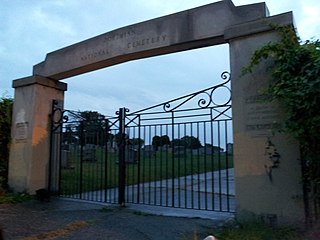
Bohemian National Cemetery, also known as Oak Hill Cemetery, is a cemetery located at 1300 Horners Lane, Armistead Gardens in East Baltimore, Maryland.
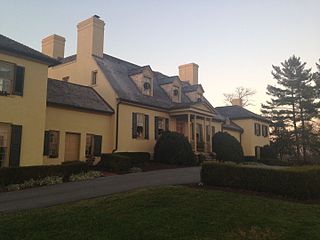
The Belmont Estate, now Belmont Manor and Historic Park, is a former plantation located at Elkridge, Howard County, Maryland, United States. Founded in the 1730s and known in the Colonial period as "Moore's Morning Choice", it was one of the earliest forced-labor farms in Howard County, Maryland. Its 1738 plantation house is one of the finest examples of Colonial Georgian architectural style in Maryland.

The Bare Hills Historic District encompasses a residential area north of Baltimore, Maryland, in Baltimore County, which had industrial beginnings before being transformed into a suburb of the city. The district includes Lake Roland Park as well as a cluster of largely vernacular dwellings between the park and Falls Turnpike that was built mainly in the 19th century.

Howard Lodge is a historic plantation house in north-central Howard County, Maryland. The main house, built around 1750 by Edward Dorsey, son of John Dorsey, is one of the oldest plantation houses in the county. Compared to other houses of the period, the two-story brick and stone structure is larger and its interior finishes better preserved. The surviving plantation property, about 15 acres (6.1 ha), also includes early 19th-century stone outbuildings. Edward Dorsey was given ownership of seven African-American slaves by his father John Dorsey.
